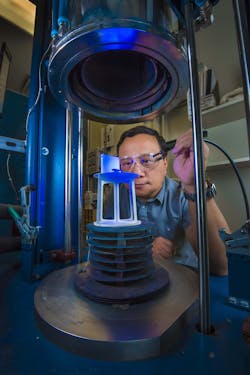Hermetic-Seal Research Solves Glass-Ceramic/Stainless-Steel Interface Issues
Stainless steel’s resistance against corrosion makes it a popular housing material for devices that need to survive harsh environments. Although electronics may be fully insulated, usually with a glass or ceramic, it is important to hermetically seal the interface between the housing and electronics to prevent shorts caused by accidental contact. At Sandia National Laboratories, Steven Dai leads an investigation to develop a failsafe seal between stainless-steel housing and insulators made of ceramic-glass. Their final goal is to achieve a processing method that can be used in wide-scale manufacturing.
A range of methods may be applied to create a seal between glass-ceramic insulators and metal housing. But most (e.g., powder soldering) require heat, which is problematic because glass-ceramic and metal have inherently different coefficients of thermal expansion, and glass-ceramic is brittle. When developing a bond between the two, the relatively rapid expansion of stainless steel can stress glass-ceramic to the point of shattering. Dai’s team carried out a range of experiments, manipulating the changes in processing temperatures to better match the crystalline phase changes of glass-ceramic to the metal’s rate of thermal expansion.
Dai’s team eschews a powder-soldering method for their own simpler method that has less intermediate steps. They doped the glass-ceramic with an oxidizing agent that, under heat, releases oxides at the interface to react with the chromium in the stainless steel (note: stainless-steel alloys may be made of iron, chromium, nickel, manganese and copper). The reaction gradually builds a strong bond at the interface.
Dai and his team tested 24 different oxidants in the glass-ceramic samples. They determined the two best performers of the group and continued to test different heating processes that would linearize the thermal expansion of the glass-ceramic. Instead of step-like strain changes as the glass-ceramic changes crystalline phases, the team worked to closely match it to the expansion rate of stainless steel.
"We need to learn that part of the process to make sure we have a good balance of all the phases, have them all crystallize in the right sequence and ideally in the right proportion," says Dai.
A provisional patent was filed in November for the interfacial bonding oxides. Finding a repeatable processing method will lead to a new generation of seals between the two highly different materials for applications ranging from fuel cells to aerospace applications.
About the Author
Leah Scully
Associate Content Producer
Leah Scully is a graduate of The College of New Jersey. She has a BS degree in Biomedical Engineering with a mechanical specialization. Leah is responsible for Machine Design’s news items that cover industry trends, research, and applied science and engineering, along with product galleries. Visit her on Facebook, or view her profile on LinkedIn.

